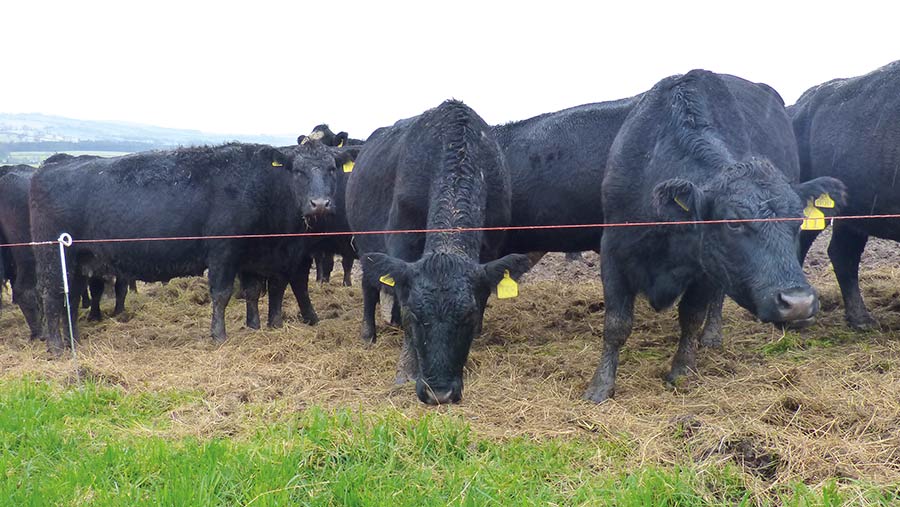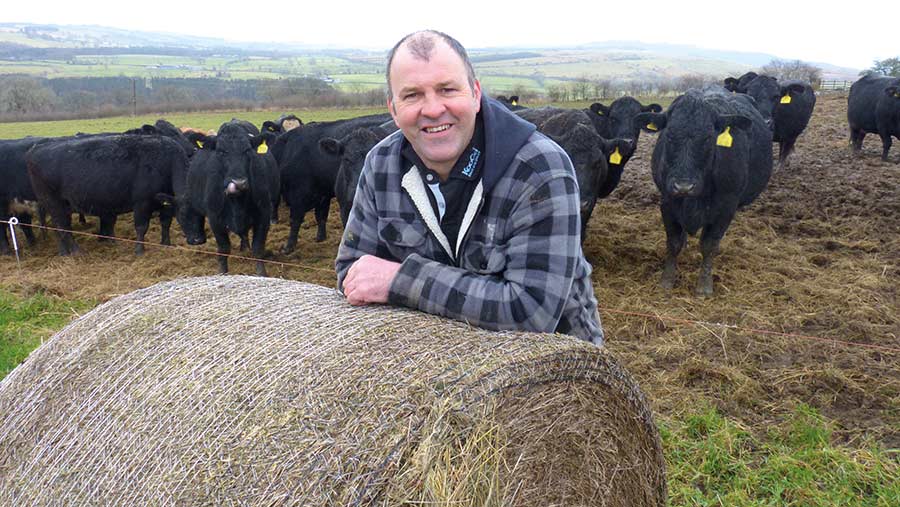Video: Maternal traits ensure fertile and low-cost sucklers
 © MAG/Michael Priestley
© MAG/Michael Priestley Sourcing functional bulls that suit a forage-only, minimal intervention organic system has led one Northumberland suckler unit to consider a three-week heifer bulling period.
It has also allowed them to take on a second holding with no cattle infrastructure and keep fixed costs low by outwintering 100 cows.
Financial necessity had already driven Angus Nelless, his brother, Duncan, and the whole team, at Thistleyhaugh, near Morpeth, to develop a system which breeds heifers for seven weeks at 15 months old.
Their minds were focused by mortgages on the home farm, Thistleyhaugh (bought in 1995), and Healey (bought in 2017), near Rothbury.
See also: How maternal genetics helped double kg output/ha
Watch the video on outwintering and read the rest of the report on breeding below.
Farm facts
- 240 cows to calve this spring
- Angus-cross and Black Baldy cows
- Angus and Hereford bulls used
- 550ha (1,360 acres) farmed in total
- 1,800 bed-and-breakfast pigs a year and Christmas poultry
- 2,100 Lleyn sheep selling 40 tups a year
- Five labour units
- Produces 300kg organic carcasses for Dovecote Park
- 90 calves weaned for every 100 cows bulled
Now the team are considering whether to reduce the time the bull spends with the heifers from seven weeks to three weeks.
This would allow tighter selection for fertility and produce a more even bunch of calves.
Conception rates are 92% for heifers and 93% in cows, with about 75-80% in-calf in the first cycle, and only 1.5% assisted at calving.
Mr Nelless admits their heifer management is very simple. “The bull breeders do the hard work, and we put faith in them to breed what we need,” he explains.
“We went organic to try and increase margin and make money by cutting out costs,” he explains. “I have some idealism in the way I farm, but we are primarily driven by finances.”

Angus Nelless © MAG/Michael Priestley
Breeding
The spring-calving herd is based on Angus-cross cows bred from a Limousin-cross herd the family had in the 1990s. More recently, Hereford bulls have been used for hybrid vigour.
The policy for heifer selection has been to bull everything correct that weighs 350kg or more at 14-15 months.
This is because the addition of Healey, a 141ha (350 acre) farm that summers 300-400 ewes and is home to 100 cows, allowed for the herd size to almost double.
Correct and docile bulls born without assistance are selected on figures as yearlings (see table below).
Bull selection criteria |
|
|
Trait |
Reason |
|
Calving ease (direct and daughters) |
Both figures are checked and should be moderate (near zero) to avoid breeding females with tight pelvises |
|
Positive fat scores |
The numbers don’t need to be too high, but a positive score ensures cattle finish off forage and helps with hardiness through winter |
|
Moderate growth and low mature cow weight |
200-, 400- and 600-day weights are moderate to avoid high mature cow weight. The lower the mature cow weight estimated breeding value the better, to keep winter feed costs and cow maintenance under control |
|
Scrotal size |
This needs to be bigger than breed average to ensure bull fertility. It also impacts on daughter fertility |
|
Moderate milk |
If milk is too high, then cows can milk off their back and fail to get in-calf. Condition is important for outwintering |
Management
No bucket, blocks or hard feed are used. The only input the farm uses is a pre-calving copper and iodine bolus.
The farm does not buy a bull specifically for heifers.
About 60 replacement heifers will be selected from a mob of 90, which will be bulled by two 15-month-old Angus bulls from 25 June for six weeks. The rest will be finished or sold for breeding.
Calves are gaining 1.1kg a head a day when they are fence-line weaned in November at 250-300kg.
The replacement heifer group is kept as a priority group and wintered on deferred grazing until January.
They are then bale-grazed on grass and clover silage at 10 MJ/kg metabolisable energy.
Grazing is deferred until March, when they graze 4-10ha (10-25 acres) of rig and furrow fields on two-to-three-day shifts.
The heifers winter and calve outside near the steading at Thistleyhaugh. They are summered and wintered again, then calve a second time as a separate group before joining the mixed-age cows.
Heifers may only average growth of 0.4kg/day through the winter. The important thing is getting heifers onto spring grass in March to grow at 1-1.2kg/day.
This is so they reach an average bulling weight of 370kg (minimum 350kg) by 25 June, explains Mr Nelless.
While this is only 65% of a 570kg mature cow weight, the Nellesses find the breed is fertile early, continues growing and ends up averaging nearer 650kg.
Top tips for managing heifers around breeding
Calving heifers for the first time at two years of age helps suckler herd profitability.
This practice results in the lifetime productivity of the heifer increasing, while also lowering carbon output.
To be successful, calving at two years requires well-thought-out use of genetics, nutrition and management, acknowledging heifers are being asked to grow themselves and a calf.
AHDB knowledge exchange managers Emma Steele and Sarah Pick give their advice.
- Ensure heifers are at least 65% of their mature weight at breeding. At this weight, the heifer will have reached puberty and be cycling.
- Keep the breeding period to six to eight weeks to ensure the most fertile females are retained. As a target, 80% of females should calve within the first six weeks of a block. A successful synchronisation programme can reduce your calving block further. Speak to your vet to discuss the options.
- Animals not in-calf after the breeding season should be culled. Retaining sub-fertile heifers incurs costs, reduces herd productivity, and increases workload
- If possible, breed heifers before the mature cow herd so you can focus on them calving, and give them more time to recover to ensure they rebreed.
- Minimise stress by avoiding management changes around breeding time. Heifers should be kept in a stable group for at least six weeks before the start of the breeding season. Changes to their environment can result in early embryonic loss – 75% of calf losses occur in the first 42 days after conception.
- Choose an easy-calving bull using estimated breeding values. At best, difficult calvings can result in poor calf performance, and the heifer is unlikely to calve again within 365 days. At worst, the heifer and calf may be lost before recouping replacement costs (at least £1,500 if calving at two years). Fewer than 10% of heifers should require assistance at calving; for cows, this should be less than 5%.
- If possible, heifers should be managed separately to the rest of the herd throughout pregnancy. Aim for a body condition score of 3 at calving. Studies have shown thin heifers are at an increased risk of calving difficulties, are less likely to rebreed and produce poorer quality colostrum.
See more on breeding replacement heifers on the AHDB website.
Maternal Matters
The AHDB initiative highlights the importance of maternal performance in driving suckler herd profitability.
The series brings you regular articles on improving suckler herd efficiency, including:
- How improved maternal performance reduces costs
- Using maternal genetics to breed profitable females
- Calving heifers at two years to reduce cost of production
- Reducing calf losses
- Heifer management for rebreeding success
Find more information on the AHDB Maternal Matters website.
